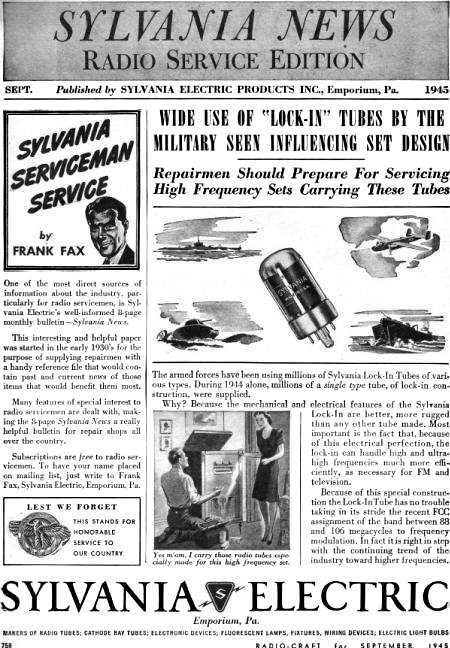Sylvania News Radio Service Edition
|
|
Once mobile and other high-vibration
and impact operational environments became the norm for communications, it became
necessary to design hardware so that electronic components would not work themselves
loose and cause intermittent or total failure. With vacuum tubes, placing locking
shields over them did the job, but that caused other issues such as increased cost,
Sylvania News Radio Service Edition
Wide use of "Lock-In" Tubes by the Military Seen Influencing Set Design Repairmen Should Prepare For Servicing High Frequency Sets Carrying These Tubes The armed forces have been using millions of Sylvania Lock-In Tubes of various types. During 1944 alone, millions of a single type tube, of lock-in construction, were supplied. Why? Because the mechanical and electrical features of the Sylvania Lock-In are better, more rugged than any other tube made. Most important is the fact that, because of this electrical perfection, the lock-in can handle high and ultra-high frequencies much more efficiently, as necessary for FM and television. Because of this special construction the Lock-In Tube has no trouble taking in its stride the recent FCC assignment of the band between 88 and 106 megacycles to frequency modulation. In fact it is right in step with the continuing trend of the industry toward higher frequencies. Yes m'am, I carry those radio tubes especially made for this high frequency set. Sylvania Serviceman Service Frank Fax One of the most direct sources of information about the industry, particularly for radio servicemen, is Sylvania Electric's well-informed 8-page monthly bulletin - Sylvania News. This interesting and helpful paper was started in the early 1930's for the purpose of supplying repairmen with a handy reference file that would contain past and current news of those items that would benefit them most. Many features of special interest to radio servicemen are dealt with, making the 8-page Sylvania News a really helpful bulletin for repair shops all over the country. Subscriptions are free to radio servicemen. To have your name placed on mailing list, just write to Frank Fax, Sylvania Electric, Emporium, Pa. Lest We Forget This Stands for Honorable Service to Or Country Sylvania Electric Emporium, Pa. Makers of Radio Tubes; Cathode Ray Tubes; Electronic Devices; Fluorescent Lamps, Fixtures, Wiring Devices; Electric Light Bulbs
Posted August 25, 2020 |
|

